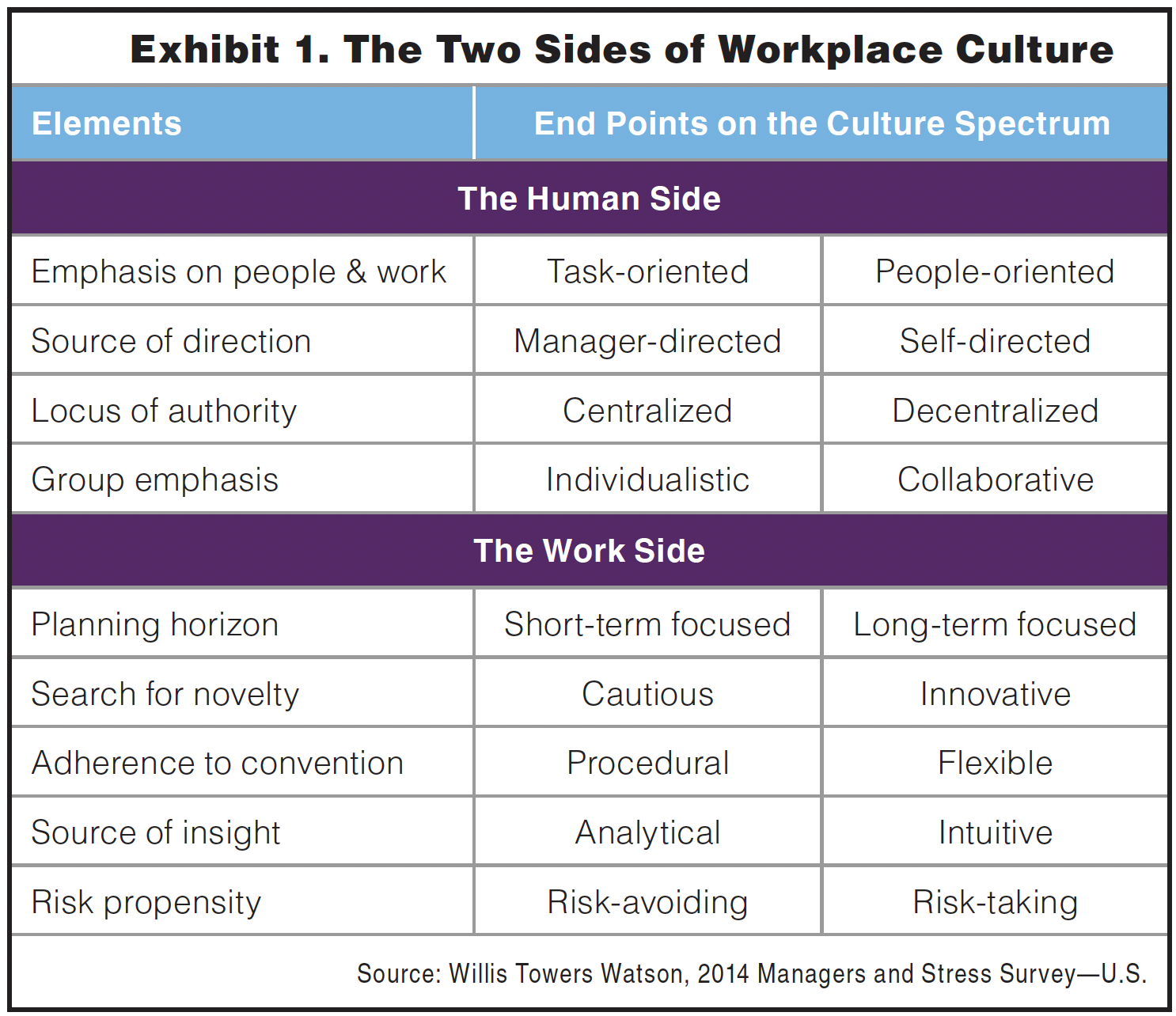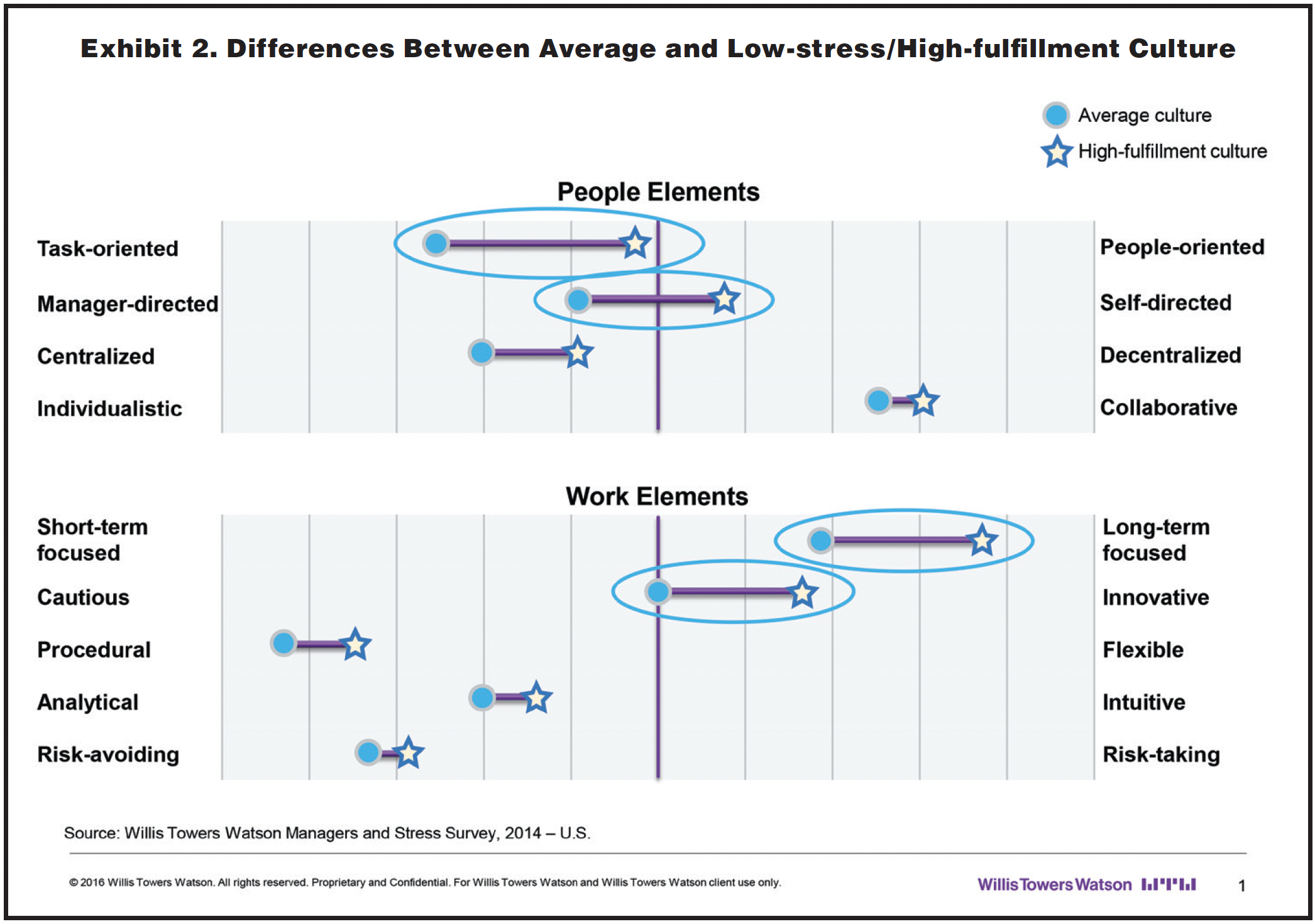By Thomas O. Davenport, Senior Consultant, Willis Towers Watson
Imagine you work in a small, high-technology company. This is the how your CEO describes his desired workplace culture: “Fire people who are not workaholics. Come on folks, this is startup life, it’s not a game…go work at the post office or Star.bucks if you want balance in your life.”1 Now imagine how toiling in such a culture would affect the amount of stress you feel at work.
To explore the links between workplace culture and perceived employee stress, Willis Towers Watson studied the stress implications of culture in medium-sized and large companies across the U.S. We gathered survey information on nine culture dimensions, divided into two categories: the human side of culture and the work side of culture. The human side encompasses the value placed on individual employees and their experiences as they do their jobs and live their lives within the company. The work side of culture influences how tasks are planned and approached. Exhibit 1 shows the four human side elements and work side elements and the descriptive end points of each culture dimension.


Exhibit 2 illustrates how non-management employees describe their organizations’ current cultures, depicted as tending toward one side or the other of each dimension (the blue circles). The exhibit also shows how people depict the human-side and work-side elements in cultures where work is less stressful and more fulfilling (shown by the stars on the graphic).
On all nine dimensions, employees in high-fulfillment cultures describe their work environments in ways that differ from the cultures currently experienced by the population more broadly. The most dramatic changes appear in the four circled areas. Employees say their workplaces would be less stressful and more fulfilling if they exhibited:
- More people orientation and less task orientation—considering the well-being of people as a precedent to, and a prerequisite for, increased productivity and reduced stress, rather than an afterthought;
- Greater opportunity for self.direction—giving employees the maximum amount of autonomy to determine how, when and where they will accomplish their jobs;
- Increased adoption of a long-term view—providing challenging work that is, to the greatest extent possible, free of unrealistic, onerous deadlines and clearly contributes to future individual growth and organizational success; and
- More emphasis on innovative solutions to problems—ensuring people have the opportunity to exercise creativity and not be artificially constrained by established, conventional approaches to work.
The critical cultural questions for leaders focus on the story beneath these findings, on the basic energizing ethic of the enterprise. Take people-orientation vs. task-orientation as an example. John Chambers, former CEO of Cisco Systems, asked to be notified within 48 hours whenever a Cisco employee or an employee’s immediate family member be.came seriously ill or died. Cisco has certain.ly never been known as a place where people don’t work hard. But when the CEO takes time away from his job to show a personal interest in employee well-being, he sends a clear message of care and concern, not just for how the work gets done, but also for the people who do it. By these actions, he pushes organizational norms toward the people side.
On the people-orientation–task-orientation dimension, as on the other eight culture dimensions, leadership’s choice of where to position the organization will ultimately define employees’ work experience and, by extension, the magnitude of stress they feel in the workplace. • Thomas Davenport is a Senior Consultant at Willis Towers Watson. He can be reached at 415-733-4280 or [email protected].
1. Aamoth, Doug, “Calacanis Fires People Who Have a Life,” March 7, 2008, http://techcrunch.com/2008/03/07/calacanis-fires.people-who-have-a-life/. Jason Calacanis subsequently updated his statement “to make my point a little less harsh, more true to my true feelings.” His modified point reads, “Fire people who don’t love their work.”







